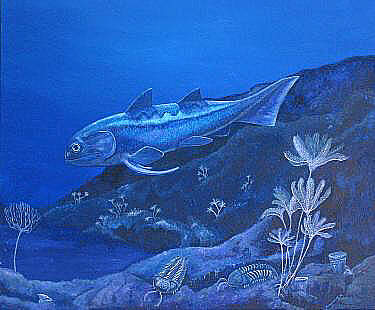
Details of the paper
| Title | The acanthodian Machaeracanthus from the Lower Devonian Hunsrück Slate of the Hunsrück region (Germany) |
| Co-Author(s) | Carole J. Burrow |
| Year: | 2007 |
| Language: | English |
| Source: | Paläontologische Zeitschrift, 81/1: 97-104 |
| Keywords: | Acanthodii, Machaeracanthus, Lower Devonian, Lower Emsian, Hunsrück Slate, Germany |
| Summary: | Two newly collected slabs, from the Lower Devonian Hunsrück Slate of Bundenbach, Hunsrück region, Germany, with spines of the acanthodian Machaeracanthus hunsrueckianum n. sp., are described. Both are associations of large and small spines, and are the first to show groupings of symmetrical pairs; the spines are not homologous with those of other acanthodians. A pair of small spines of M. peracutus NEWBERRY, 1857 from the Karschheck quarry near Oberkirn, Hunsrück region, Germany, is articulated with the pectoral girdle, and is the first such complex to be described. The only spines which Machaeracanthus appears to have had were a pair of large and small pectoral spines on each side of the body. These spines could have helped to prevent the fish from sinking into the mud while resting on the sea floor. Painting: W. Verhesen, Herten, the Netherlands for the Hunsrück-Museum, Simmern, Germany. |
| Reaction 1: | Klug et al. (2008; in Palaontographica, Abt. A, 283(4-6): 158) describe 88 fin-spine fragments of Machaeracanthus cf. peracutus from the Emsian of the Tafilalt(Morocco). Although one piece of asymmetrical fin-spines were found next to each other, the Moroccan specimens provide no evidence for the reconstruction of paired small and large pectoral spines. |
| Reaction 2: | The paper of De Baets et al. (2013): "Emsian Ammonoidea and the age of the Hunsrück Slate (Rhenish Mountains, Western Germany)" in Palaeontographica, Abt. A, Volume 299, Issues 1-6: 1-113, contains a painting/life impression produced by Eleonore Ware. The reconstruction of the acanthodian Machaeracanthus hunsrueckianum is based on Südkamp & Burrow (2007). |
| Reaction 3: | Ferrón et al. (2022), in their paper: Biomechanics of Machaeracanthus pectoral fin spines provide evidence for distinctive spine functions and lifestyle among early chondrichthyans, have tested our hypothesis that the pectoral spines could have been used as ‘snow-shoes’ to lay on and prevent sinking into the substrate below or even to propel itself along the bottom. Based on the cross-sectional shape and their resistance to bending and torsion these authors concluded, that the pectoral spines of Machaeracanthus are better suited than those of ‘conventional’ acanthodians and living catfishes. The last are compatible with a defensive function. The superior resistance to bending and torsion at the middle region of Machaeracanthus pectoral fin spines support our hypothesis. |

[Home] [Book - Life in Devonian] [Contact]
| Homepage last update: 26.04.2024 © ´2024 Südkamp - Exkursionen | wouter(x)suedkamp-exkursionen.de Impressum Datenschutz |
Webmaster: peter.holze(x)hunsnet.de |